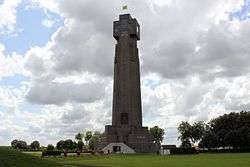Yser Tower
The Yser Tower (Dutch: IJzertoren) is a monument near the Yser river at Diksmuide in Belgium. It was built to commemorate the soldiers killed on the Yser Front in World War I and pacifism but subsequently became an important political symbol for the Flemish Movement. The original monument was constructed in 1930 but was destroyed in 1946 as a result of its political associations with Flemish nationalist collaboration after World War II. The current tower was rebuilt alongside the remains of the original and was finished in 1965. It remains a site of political significance to Flemish nationalists and is the center for their annual Yser Pilgrimage (IJzerbedevaart).

Tower
First tower, 1930–1946
The idea for a distinct monument in Flanders to commemorate the Flemish soldiers killed in the Belgian Army in World War I had been discussed since 1916 since at least 1916 under the patronage of the priest Cyriel Verschaeve. The project was associated with the Flemish Movement and particularly the former Frontbeweging which had emerged among Flemish soldiers themselves. After some initial efforts, construction on a 50 metres (160 ft)-high tower-shaped monument near the Yser river at Kaaskerke near Diksmuide began in 1928. The site was symbolic because the Yser had represented the front-line of the Belgian Army for most of the war. The tower was finished in 1930 and incorporated the Frontbeweging's cruciform motto "All for Flanders—Flanders for Christ" (Alles Voor Vlaanderen, Vlaanderen Voor Kristus, AVV—VVK) and was unveiled at the 11th annual Yser Pilgrimage (IJzerbedevaart). In following years, the human remains of a number of "Yser Symbols" (IJzersymbolen) were reburied in the crypt of the tower, including the Van Raemdonck Brothers. Initially associated with pacificism, the site soon became one of the most important symbolic places for the Flemish Movement.
The association of the Flemish Movement with collaborationism in German occupation of Belgium during World War II led two former members of the Belgian Resistance to illegally destroy the tower with dynamite on the night of 15–16 March 1946 as a reprisal. The ruins of the first tower were retained and transformed into the Peace Gate (Paxpoort) in 1950.
Second tower, 1965–present
The second tower still stands at the site near to the remnants of the first. It was built to roughly the same design as the first but is larger (84 metres (276 ft)). Work began in 1951 and was not finished until 1965. It houses a museum on Oorlog, vrede en Vlaamse ontvoogding (War, Peace, and Flemish Emancipation), that belongs to the United Nations network of peace museums. The museum houses the large painting, The Golden Canvass of Flanders (Het Gulden Doek van Vlaanderen) by Dutch-born Belgian painter Henry Luyten. The painting depicts a fictional meeting of the one hundred people who in Luyten's opinion played the most important roles in Flemish history.